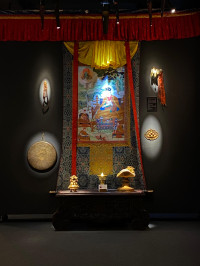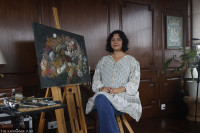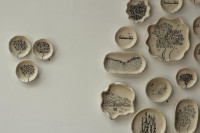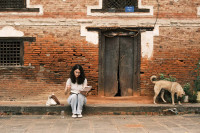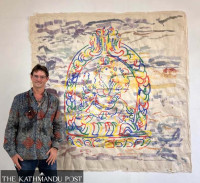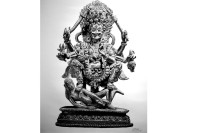Arts
A mixed media exploration of identity
Two artists, one question: ‘Who Are.You’ is a compelling exploration of self through philosophy.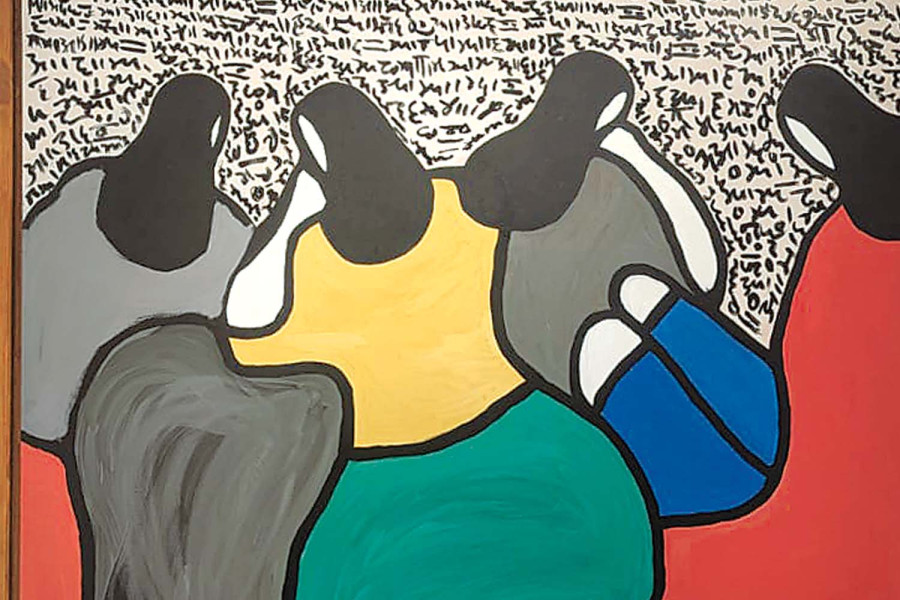
Aarya Chand
Today, art is no longer confined to being the sole method for expressing visual identity. Instead, it has become one of many mixed forms shaped by the dynamic interplay of media, technology, and design. The exhibition ‘Who Are.You’ reflects this fragmented landscape of visual expression, exploring how identity can emerge through unconventional mediums.
The exhibit pushes the boundaries of classical artistic traditions using materials like resin, nails, sculptures, and televisions. It invites viewers to immerse themselves in a narrative as complex as the human experience. This journey speaks not only to the eyes but also to the complexities of modern existence.
Visual culture is not a singular entity; instead, all mediated representations are interconnected. As a German art historian and media theorist Hans Belting suggests: “It is obvious that media come rarely by themselves and usually exist as what is called mixed media.” This is reflected in the exhibition, where artworks are paired with videos, and pieces crafted from plaster and resin embody the fusion of classical and modern techniques.
Artists Mukhiya Samridh and Subesh KC have been friends for over a decade. They had planned a small exhibition at KCAC which is the Kathmandu Contemporary Arts Center, the former space of Siddhartha Art Gallery. However, life took them in different directions—Samridh moved to the United States, and KC to Norway—causing their early plans to fall through.
Fifteen years later, their paths crossed again when they both returned to Nepal and Sangeeta Thapa, the founder of Siddhartha Art Gallery, approached both artists with the opportunity to create something unique.
They spent three to four months reflecting on their shared concept. At this point, they found themselves at a similar stage in life, both grappling with existential questions about the meaning of life and their place within it. This shared contemplation led them to the idea of crafting an exhibition centred around these very themes.
Their decision set them on a six-month journey to shape the exhibition’s concept. While they shared common qualities, their differing perspectives on life sparked a rich exchange of ideas. This constant back-and-forth dialogue, where they challenged one another’s worldviews and posed questions, slowly brought their vision into focus.
The first piece I encountered, which they created together, is titled ‘Status Quo’, which reflects the current state of things. However, upon closer inspection, it revealed a deeper complexity. The artwork is composed of 30000 nails. At first, I failed to notice that it was nails, but as I moved closer, their presence became clear.
The nails represent one’s position in life, spread across a spectrum to symbolise individuals. The hammering reflects the societal pressures that shape us, raising questions such as, “What should I do with my life?” and “Where do I fit in society?”
The curve in the artwork holds additional meaning, such as energy, the fundamental force of the universe, which manifests in waves. This curve begins on the left, representing the ‘mount of stupid’–a time when we believe we know everything.
Emphasising it, Samridh says, “As your island of knowledge grows, so does your ignorance.” The downward slope symbolises the humbling realisation of life’s bitter truths, leading to the understanding of humility. The other end of the curve, a valley of despair, marks where the journey begins. Ultimately, the curve ascends to a slope of enlightenment, which is very hard to achieve.
As Samridh described the piece, I saw clear parallels with Erikson’s four stages of psychosocial development, a concept studied in psychology. Erikson’s theory outlines how individuals evolve through distinct stages of development, each marked by unique challenges and crises.
KC adds, “It's like a curve of confidence and competence, like X and Y. One can be confident but not competent, and vice versa.” This suggests that life’s journey isn’t just about gaining knowledge; instead, it involves growth in wisdom and spirit. The curve suggests that life’s challenges continue to evolve.
This piece invites the audience to reflect and find their meaning. Psychiatrist Klaus Conrad coined the term ‘Apophenia,’ which refers to the tendency to perceive patterns or connections in random or unrelated things. As viewers stand before the artwork, they, too, can experience this phenomenon, discovering their own interpretations and connections.

Samridh also says, “We’re not dictating how the audience should perceive the artwork, as we believe that once the artist has completed their work, their job is finished. Art is what happens between the art and the observer itself.” This belief aligns closely with the theory of aesthetic formalism, which emphasises the importance of form and structure in art rather than the artist’s intentions or external context.
According to this view, the artwork’s meaning emerges from the viewer’s direct engagement, allowing the observer to interpret and experience the art independently of the artist’s original intent.
By adopting this approach, the artists encourage the audience to explore their interpretations, reflecting that art’s value lies in the personal experience it provokes. In line with proceduralism, which asserts that a single, fixed interpretation does not determine the meaning of a work but evolves through engagement with its form, the exhibition invites viewers to find their own connections to the theme of ‘Who Are. You’.
The intention is not to impose a singular meaning but to open up a space for individual reflection and discovery. Each viewer’s response becomes an integral part of the art, allowing for a richer and more diverse understanding of its significance.
The exhibition’s title, ‘Who Are.You’, intrigues with its unconventional punctuation. KC explains that the full stop after ‘are’ disrupts linguistic norms, drawing attention to the question’s structure. This linguistic play invites viewers to pause and reflect, mirroring the introspection central to the exhibition’s theme.
He argues language is intrinsic to identity, shaping realities and perceptions. The exhibition’s asemic writing style reflects the abstract nature of existence, encouraging viewers to embrace ambiguity and explore their inner selves.
“With its inability to express inner experiences completely, the painting takes the form of a constructed image dealing with things for which I do not have proper language. With repetition of symbols and forms, I create something that language is unable to,” says KC.
The philosophical insights of Ludwig Wittgenstein, Maurice Merleau-Ponty, Theodor Adorno, Noam Chomsky, and Martin Heidegger resonate deeply in his artistic vision. The influence of Heidegger’s philosophy is evident in the four-part structures present in KC’s work. His piece, ‘Future is the Predominant Tense’, reflects the exploration of time, emphasising the interconnectedness of past, present, and future.
In his upper-floor piece, ‘Alienation’, he reflects on death as the only certainty, yet an experience we can never truly have. KC also embraces the Japanese concept of wabi-sabi, which celebrates the beauty of imperfection and incompleteness.
By leaving his work unfinished, he values the aesthetic of imperfection, allowing viewers to appreciate life’s fleeting nature and imperfections, much like the innocence of childlike behaviour. “It took me four years to paint like Raphael, but a lifetime to paint like a child.” Pablo Picasso’s quote captures the essence of the artist’s intent: to return to a pure, innocent state of mind.
Samridh chose to approach this exhibition differently, creating his pieces in white and removing emotion from the process. Following stoic philosophy, which aligns with Vedic philosophy, his work focuses on philosophies like Maya (illusion), Purusha (consciousness), and Prakriti (elements); his work represents an absence of ego. Keeping the artworks on display with no sign emphasises this too.
In their approaches, the artists reflect different philosophical influences. Samridh’s work seems driven by a search for meaning, while KC embraces the concept of self-liberation, accepting life without the need for deep answers.
Yet, in their final collaborative piece, they come together. Titled ‘I AM Becoming’ by Samridh and ‘All is One’ by KC. The pieces are minimalistic, white and represent singularity, echoing the unity in Eastern and Western philosophies.
‘I AM Becoming’ represents Samridh’s journey to rediscover his childhood innocence before the world taints him. He seeks to unite his future self with the child he once was. On the other hand, ‘All is One’ reflects the belief that all existence is part of a unified whole, an essential truth found through time.
‘Who Are.You’ is not merely an exhibition; it is an experience. It challenges viewers to confront their notions of identity to engage with art personally. The exhibition’s strength lies in its ability to spark dialogue between the artworks and the viewers.
____
Who Are.You
When: January 24 to February 19
Where: Siddhartha Art Gallery, Babermahal Revisited
Time: Sunday to Friday: 11:00 am to 5:00 pm, Saturday: 12:oo pm to 5 pm
Entry: Free




 24.12°C Kathmandu
24.12°C Kathmandu
